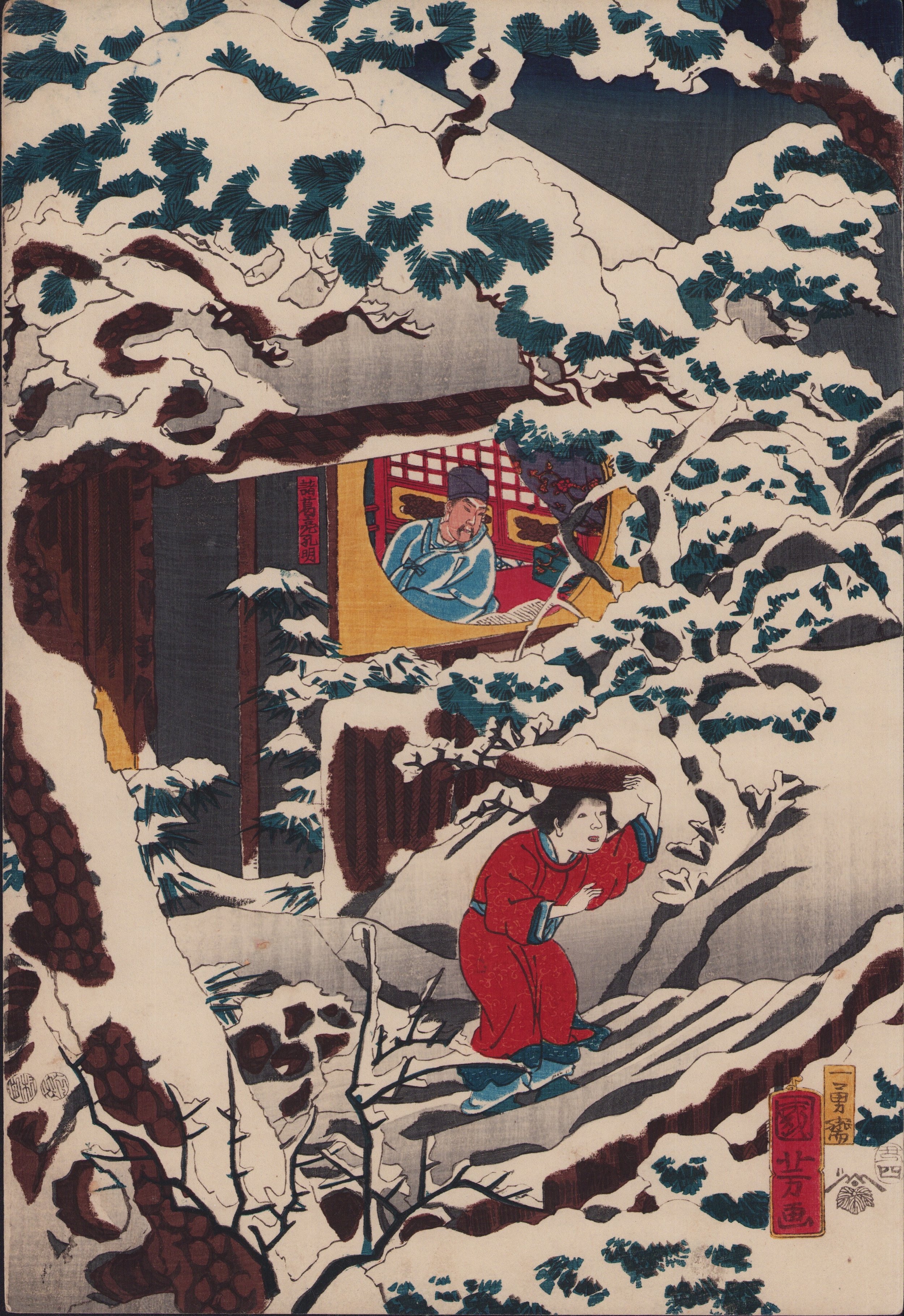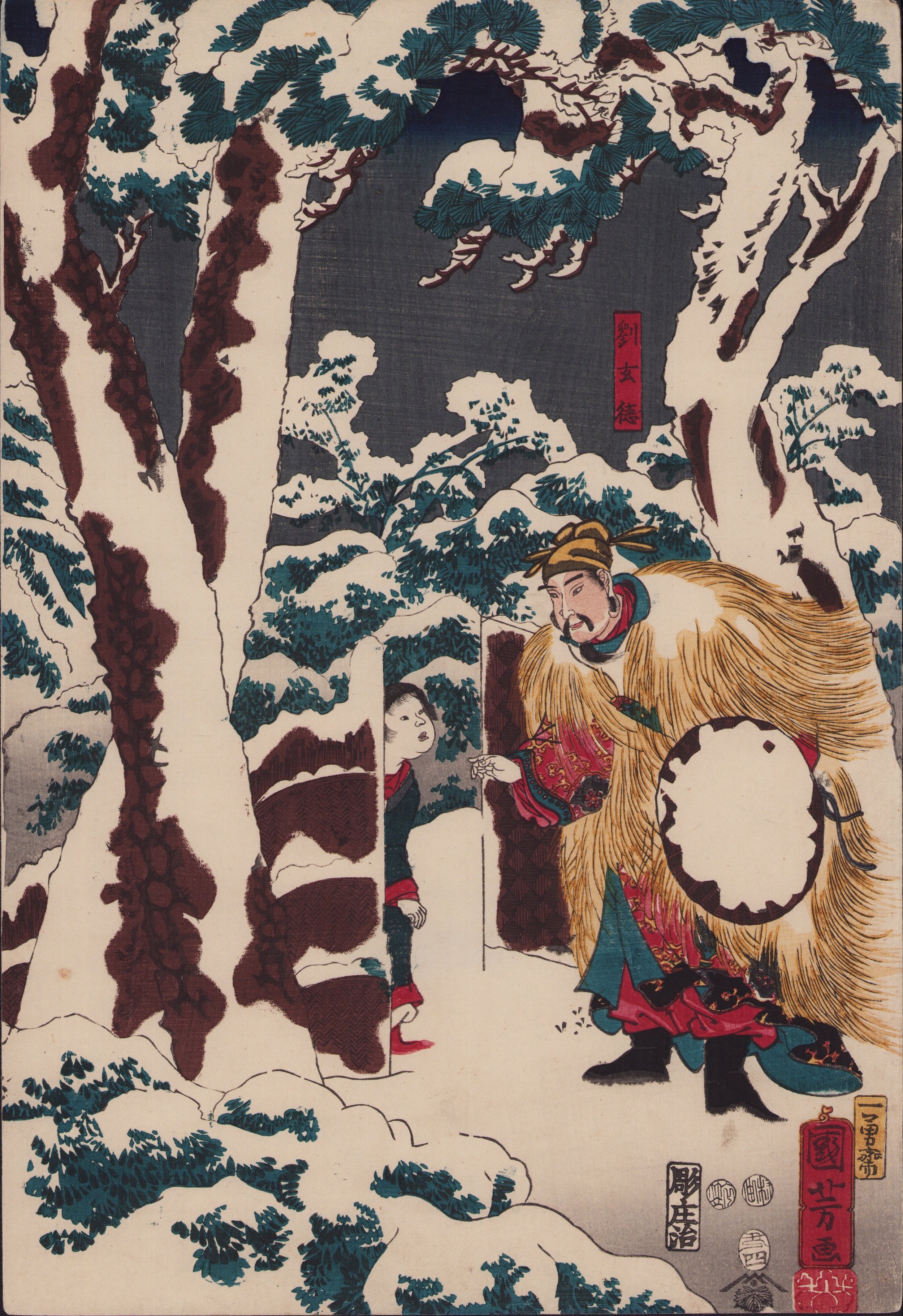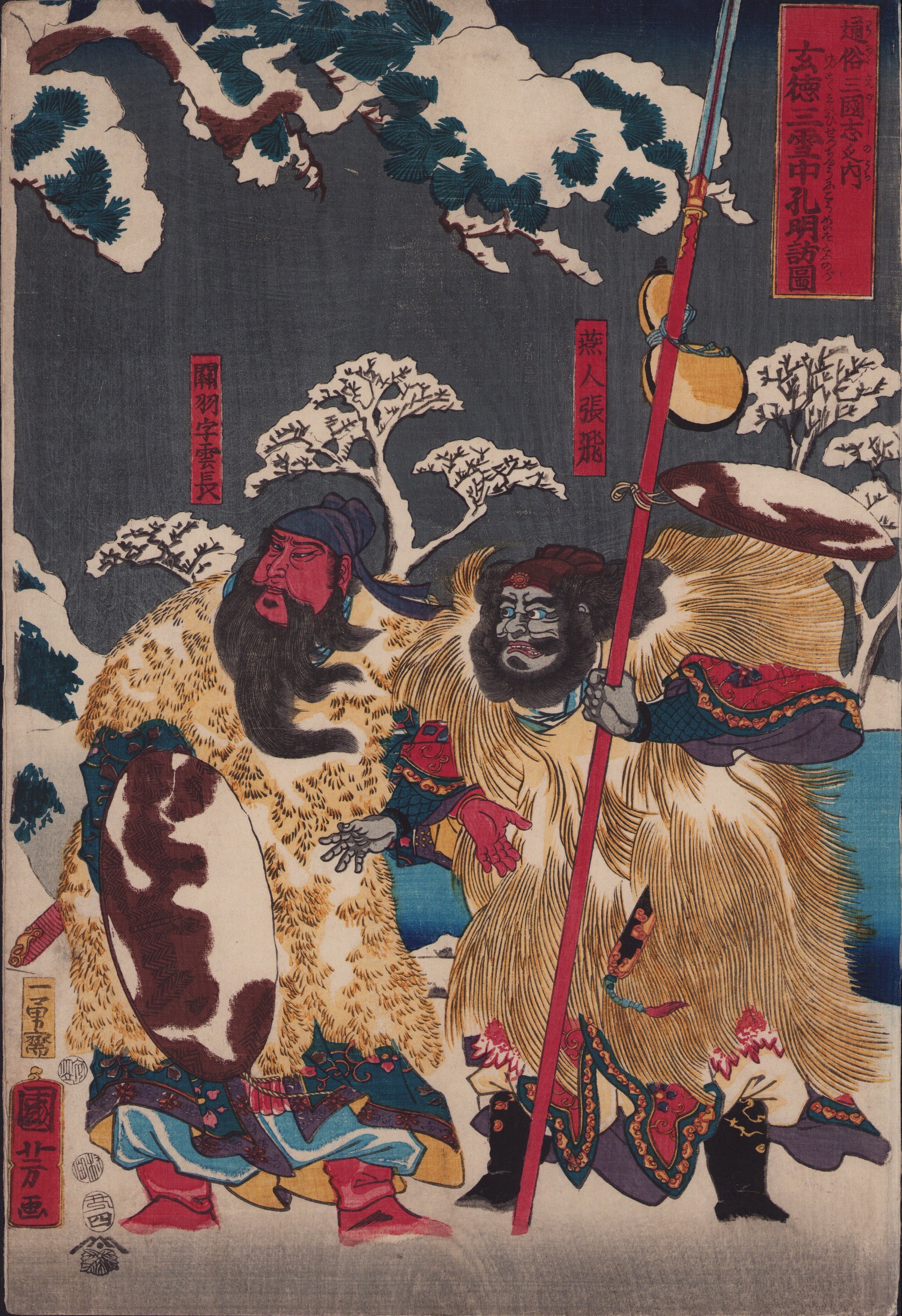Kuniyoshi | Liu Bei Visits Kongming Three Times in the Snow
歌川国芳 Utagawa Kuniyoshi (1798–1861)
通俗三国志之内 玄德三雪中孔明访图
Xuande [Liu Bei] Visits Kongming [Zhuge Liang] Three Times in the Snow, from the series Popular Romance of the Three Kingdoms
1853
木版画 | 三联续绘-纵绘大判 | 35.5cm x 25cm x 3
Woodblock-print | Triptych-Oban-tate-e | 35.5cm x 25cm x 3
品相完好;边缘经轻微修剪;经托底
Fine condition; slight trimming; backing
$3,200
江户初期,《三国演义》传入日本。十七世纪末,由湖南文山翻译的《通俗三国志》问世,激起了江户仔们的极大热情,各种话本、绘本、浮世绘此后层出不穷,开启了日本经久不衰的“三国热”。今日这件三联绘,就取材于一个著名的三国故事——《三顾茅庐》。按照《三国演义》记载,刘备初至隆中访诸葛亮不遇;数日后,刘备与关羽,张飞一同再次寻访。此时正值隆冬,天气严寒,三人才行数里,忽然便“朔风凛凛,瑞雪霏霏”,这场瑞雪,也就为本画定下了背景基调:后方一角天空彤云密布,由远及近的枯树、老松、竹枝好似蜡塑,柴扉、石阶、茅庐皆被银装;人物蓑衣斗笠玉屑斑驳,积雪可掩靴面;从众人的鬓角须髯,以及张飞丈八蛇矛上系着的斗笠与酒葫芦飘起的角度看,北风也刮得正紧。画面右下方站位最前的刘备,正询问应门的童子,态度温和而恳切;在他后方是关羽关云长,面若重枣,五绺长髯,双眉微蹙,不怒自威;最右侧的张飞,肤色灰黑,双眼圆瞪,虎面含嗔,一看就是对风雪交加上山访“村夫”颇有怨言,怒气冲冲便想持矛上前。若不是关二爷的一手阻拦,他必会大闹卧龙岗。三个人物,三种神态,都定格在了最鲜活的瞬间。而我们的诸葛亮,则在画面左侧的茅庐中半倚书桌,布衣纶巾,一副“山人自有妙计”的模样。虽仅占画面一角,但众人却皆因他而动,以动衬静,谁是“主角”,不言而喻。好的叙事画,可以超越故事本身。
Interested in purchasing?
Please contact us.
歌川国芳 Utagawa Kuniyoshi (1798–1861)
通俗三国志之内 玄德三雪中孔明访图
Xuande [Liu Bei] Visits Kongming [Zhuge Liang] Three Times in the Snow, from the series Popular Romance of the Three Kingdoms
1853
木版画 | 三联续绘-纵绘大判 | 35.5cm x 25cm x 3
Woodblock-print | Triptych-Oban-tate-e | 35.5cm x 25cm x 3
品相完好;边缘经轻微修剪;经托底
Fine condition; slight trimming; backing
$3,200
江户初期,《三国演义》传入日本。十七世纪末,由湖南文山翻译的《通俗三国志》问世,激起了江户仔们的极大热情,各种话本、绘本、浮世绘此后层出不穷,开启了日本经久不衰的“三国热”。今日这件三联绘,就取材于一个著名的三国故事——《三顾茅庐》。按照《三国演义》记载,刘备初至隆中访诸葛亮不遇;数日后,刘备与关羽,张飞一同再次寻访。此时正值隆冬,天气严寒,三人才行数里,忽然便“朔风凛凛,瑞雪霏霏”,这场瑞雪,也就为本画定下了背景基调:后方一角天空彤云密布,由远及近的枯树、老松、竹枝好似蜡塑,柴扉、石阶、茅庐皆被银装;人物蓑衣斗笠玉屑斑驳,积雪可掩靴面;从众人的鬓角须髯,以及张飞丈八蛇矛上系着的斗笠与酒葫芦飘起的角度看,北风也刮得正紧。画面右下方站位最前的刘备,正询问应门的童子,态度温和而恳切;在他后方是关羽关云长,面若重枣,五绺长髯,双眉微蹙,不怒自威;最右侧的张飞,肤色灰黑,双眼圆瞪,虎面含嗔,一看就是对风雪交加上山访“村夫”颇有怨言,怒气冲冲便想持矛上前。若不是关二爷的一手阻拦,他必会大闹卧龙岗。三个人物,三种神态,都定格在了最鲜活的瞬间。而我们的诸葛亮,则在画面左侧的茅庐中半倚书桌,布衣纶巾,一副“山人自有妙计”的模样。虽仅占画面一角,但众人却皆因他而动,以动衬静,谁是“主角”,不言而喻。好的叙事画,可以超越故事本身。
Interested in purchasing?
Please contact us.
歌川国芳 Utagawa Kuniyoshi (1798–1861)
通俗三国志之内 玄德三雪中孔明访图
Xuande [Liu Bei] Visits Kongming [Zhuge Liang] Three Times in the Snow, from the series Popular Romance of the Three Kingdoms
1853
木版画 | 三联续绘-纵绘大判 | 35.5cm x 25cm x 3
Woodblock-print | Triptych-Oban-tate-e | 35.5cm x 25cm x 3
品相完好;边缘经轻微修剪;经托底
Fine condition; slight trimming; backing
$3,200
江户初期,《三国演义》传入日本。十七世纪末,由湖南文山翻译的《通俗三国志》问世,激起了江户仔们的极大热情,各种话本、绘本、浮世绘此后层出不穷,开启了日本经久不衰的“三国热”。今日这件三联绘,就取材于一个著名的三国故事——《三顾茅庐》。按照《三国演义》记载,刘备初至隆中访诸葛亮不遇;数日后,刘备与关羽,张飞一同再次寻访。此时正值隆冬,天气严寒,三人才行数里,忽然便“朔风凛凛,瑞雪霏霏”,这场瑞雪,也就为本画定下了背景基调:后方一角天空彤云密布,由远及近的枯树、老松、竹枝好似蜡塑,柴扉、石阶、茅庐皆被银装;人物蓑衣斗笠玉屑斑驳,积雪可掩靴面;从众人的鬓角须髯,以及张飞丈八蛇矛上系着的斗笠与酒葫芦飘起的角度看,北风也刮得正紧。画面右下方站位最前的刘备,正询问应门的童子,态度温和而恳切;在他后方是关羽关云长,面若重枣,五绺长髯,双眉微蹙,不怒自威;最右侧的张飞,肤色灰黑,双眼圆瞪,虎面含嗔,一看就是对风雪交加上山访“村夫”颇有怨言,怒气冲冲便想持矛上前。若不是关二爷的一手阻拦,他必会大闹卧龙岗。三个人物,三种神态,都定格在了最鲜活的瞬间。而我们的诸葛亮,则在画面左侧的茅庐中半倚书桌,布衣纶巾,一副“山人自有妙计”的模样。虽仅占画面一角,但众人却皆因他而动,以动衬静,谁是“主角”,不言而喻。好的叙事画,可以超越故事本身。
Interested in purchasing?
Please contact us.
Utagawa Kuniyoshi (1798–1861)
Warriors, ghosts, crabs and cats.
The woodblock print designs of Utagawa Kuniyoshi, one of Ukiyo-e’s most vibrant and creative 19th Century masters, encompass more than that – he depicted landscapes and beautiful women, too – but those are the first genres that come to mind when contemplating this wonderful and eccentric genius and his sprawling, timeless body of work.
From an early age, the young Kuniyoshi was fascinated by drama and history – with a big helping of the supernatural. He loved nature and animals, too – especially cats: again and again they pop up in designs throughout his career (adding a premium to the prices those woodblock prints fetch today). Starting out as a relatively traditional student of the Utagawa school, he soon developed his hugely energetic style, full of dynamic action, and eventually passed it on to his many students – Yoshitoshi being the most famous. Along with Kunisada and Hiroshige, he was among the most prolific of all Ukiyo-e artists.
He was born Yoshisaburō on January 1, 1798 to a silk dyer. Some say his father’s rich patterns influenced his bold, colorful designs. He always loved legends and history. By age 12 he had shown a talent for drawing and become a student of the great Toyokuni, who gave him the name Kuniyoshi. He also studied the Tosa, Kano and Maruyama painting styles.
It took awhile for him to find his place in the thriving Ukiyo-e world. Then in the 1820s he produced his first epic warrior triptychs, and his career success was assured. He often gave legendary heroes fanciful and intricate tattoos of his own design, starting a style craze in Edo.
He eventually expanded genres to include animal studies and landscapes. His wonderful oban yoko-e series of “Famous Views of the Eastern Capital” is especially interesting for its use of Western motifs, such as shadows, billowing clouds and a low vantage point to create atmospheric perspective. While these efforts weren’t always entirely successful, they still resulted in wonderfully lively Ukiyo-e designs.
In all, he produced nearly 250 series for 150 publishers.
During the Tempo reforms of the 1840s, which dramatically censured woodblock prints, he boldly skirted rules barring depictions of actors by putting their faces on various animals, such as turtles.
He died at the age of 63 in April 1861 in his home in Genyadana.
Partial citation: Marks, Andreas, Japanese Woodblock Prints, Artists, Publishers and Masterworks: 1680-1900 (Tuttle; 2010)




